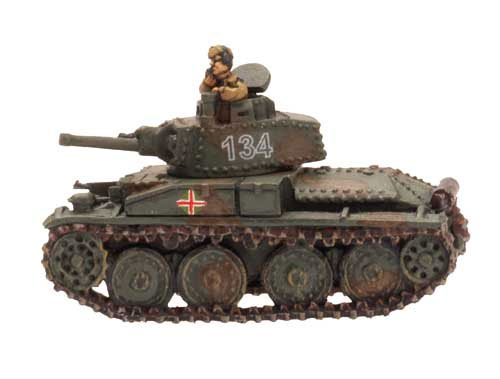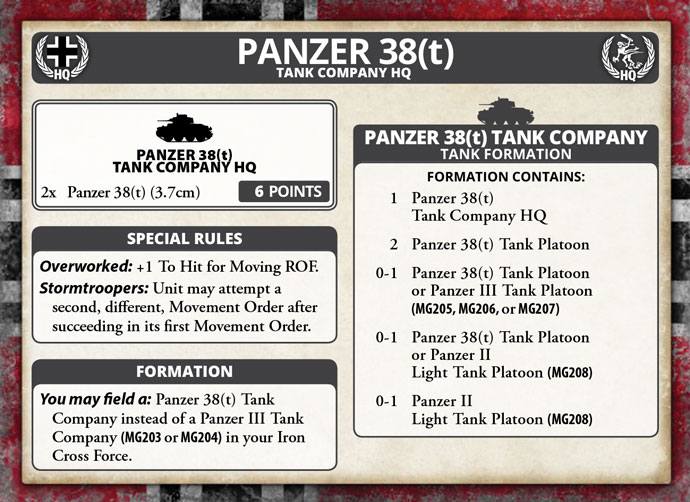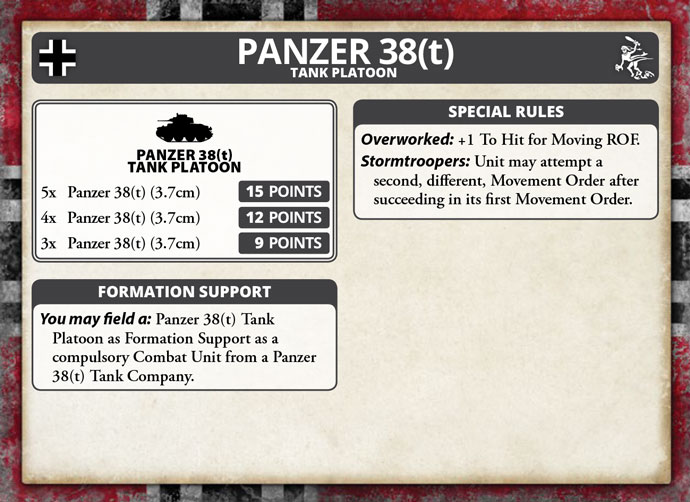|
|
 |
|
|
History of the 38(t)
|

|
History Of The 38(t)
with Ryan Jeffares
The Panzer 38(t) was a tank that was not originally developed by Germany. In fact it was designed in Czechoslovakia as the LT-38 or Light Tank model 38. The tank was designed by the CKD company and was in the early stages of production in 1938 when Czechoslovakia was annexed by the German Reich. Superior to the German Panzer I and II, the Germans continued the production of the LT-38, placing it into service as the Panzer 38(t), where the t stands for tschechisch, the German word for Czech. The continued production of the Panzer 38(t) enabled the Germans to expand their panzer forces and make up for the shortfall in Panzer III and Panzer IV production before the outbreak of the Second World War.
|
Iron Cross
By the end of 1941, the German blitzkrieg had swept across open plains of the Soviet Union and stopped at the gates of Moscow as winter set in. The halt was only temporary as the Germans were back on the offensive in the summer of 1942. The attack sliced into the southern front, aiming at the oilfields of the Caucasus. Two army groups charged forward, one heading to the mountain country in the south, the other focussed on a small city on the Volga River called Stalingrad. The unstoppable German offensive was pushing Soviet morale to a breaking point as the most pivotal battles on the Eastern Front were about to be fought on the streets of Stalingrad and in the Russian Steppe.
Learn more about Iron Cross here... |
 |
|
The Panzer 38(t) saw service in the German Army throughout the early stages of the war, being used in Poland and France in various Panzer and Light Divisions. By the time of the invasion of the Soviet Union in 1941, the Panzer 38(t) made up a significant proportion of German tank strength, being fielded in 7. ,8., 12., 19. and 20. Panzer Divisions. However, against the Soviet T-34s and KV tanks, the Panzer 38(t) proved lacking, with a gun which was too weak to penetrate their frontal armour. Furthermore, due to the tank’s small turret ring, it proved impossible to upgun the Panzer 38(t) with a more powerful gun and as a result, the production of Panzer 38(t) tanks would be halted in 1942 in order to focus on the construction of tank destroyers mounted on the 38(t)’s chassis.
|
|
By 1942, despite its inadequacy against the T-34 and KV tanks, the remaining Panzer 38(t)s still saw active combat, although their numbers dwindled due to losses and a lack of replacement tanks. The final Panzer Division to be equipped with Panzer 38(t)s was the 22. Panzer Division, which counterattacked the Soviet forces trying to encircle Stalingrad in Operation Uranus. The counterattack was troubled from the start, as many of the Division’s tanks suffered from mechanical failures because field mice had chewed the electrical wiring of these tanks whilst they were held in reserve. When 22. Panzer Division’s attack finally started it was rapidly overwhelmed by the Soviet forces and although the survivors were able to withdraw to friendly lines, the Division was so heavily mauled that it would later be disbanded.
|
|
Fielding the Panzer 38(t)
There are two ways to field Panzer 38(t) tanks in a Mid War German force, either as a support unit for a formation from Iron Cross or as part of a Czech Tank Company formation. This new formation differs from previous German tank formations as it is made up primarily of Panzer 38(t) tanks.
The compulsory units for this formation are an HQ Platoon of two Panzer 38(t) tanks and two Panzer 38(t) Platoons of three to five tanks. In addition to these compulsory choices, the formation can also include either a Panzer III Platoon or a Panzer 38(t) Platoon and either a Panzer II Platoon or another Panzer 38(t) platoon.
|
 |
 |
 |
 |
|
The Panzer 38(t) offers the Germans the light armour option that is usually absent from their forces apart from platoons of Panzer IIs, enabling you to offset the high points costs of Panzer IIIs and IVs. The high skill of a Panzer 38(t) coupled with its relatively low points cost enables it to function as a light assault tank, as long as enemy anti-tank assets have been pinned or destroyed. Furthermore, despite its weak gun, the Panzer 38(t) can still be used to threaten isolated enemy units or to flank enemy tanks which its weak 3.7cm gun would otherwise struggle to penetrate.
By including Panzer 38(t)s alongside heavier Panzers, you can bulk out your numbers while relying on your Panzer IIIs and IVs to engage enemy tanks and eliminate enemy anti-tank guns before you launch an assault with the lighter Panzer 38(t)s. Panzer 38(t)s can also provide infantry-based forces with a mobile reserve, able to threaten enemy infantry and to a lesser degree, tanks. In this role, Panzer 38(t)s act as the ‘cavalry’ to your dug in infantry and guns, racing to the rescue from reserve while your infantry holds your objectives, screened by your artillery and anti-tank guns.
|
|
Sample Panzer List
Czech Tank Company:
2 HQ Panzer 38(t) 6
5 Panzer 38(t) 15
5 Panzer 38(t) 15
5 Panzer II 10
5 Panzer III (Short) 25
Support:
3 Marders 12
4 10.5cm Howitzer 14
1 Panzer II OP 2
Command Card:
Pure Luck 1
Total: 100
|
|
In this list, the Panzer 38(t) and Panzer II tanks form the bulk of your force, supported by a platoon of Panzer IIIs. The anti-tank deficiency of the weaker tanks is offset by the inclusion of Marders and 8.8cm guns, whose role is to eliminate tanks while the 10.5cm artillery targets enemy anti-tank assets. Once the enemy anti-tank weaponry has been eliminated or supressed, the Panzer IIs and Panzer 38(t)s can then assault enemy infantry and move in to secure objectives.
|
|
|
Sample Infantry List
Grenadier Company:
Grenadier HQ 2
Grenadier Platoon (7 teams) 9
Grenadier Platoon (7 teams) 9
4 8cm Mortars 6
4 5cm guns 16
Support:
3 8.8cm AA Guns 18
5 Panzer 38(t) 15
5 Panzer III (Short) 25
Total: 100
|
|
This list is a far more traditional defensive list, with the grenadiers digging in on your objectives backed up by the 5cm and 8.8cm guns which will provide a defence against enemy tanks. The mortars will provide your force with a measure of protection against enemy artillery through counterbattery fire and can also take on targets of opportunity such as enemy infantry in the open. In this list the Panzer 38(t)s and Panzer IIIs serve as a mobile reserve, and will race to the rescue of your grenadiers after arriving from reserves. In this role the Panzer IIIs are suited to tackling enemy tanks due to their powerful 5cm guns while the Panzer 38(t)s engage enemy infantry and light vehicles or flank enemy tanks.
|
|
|
|